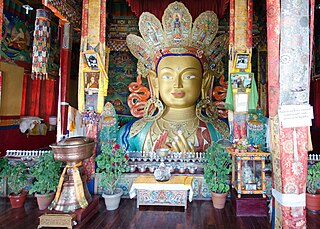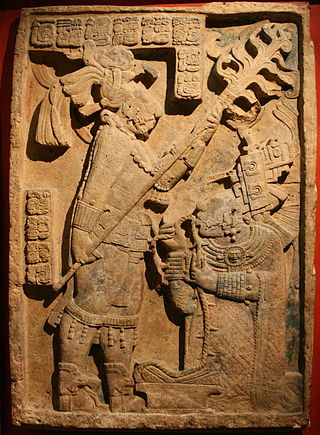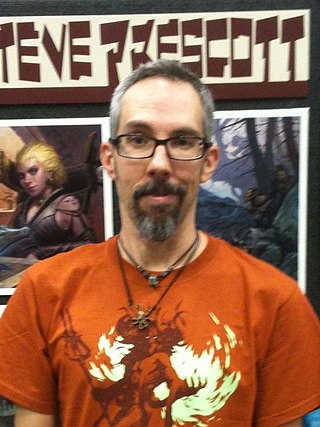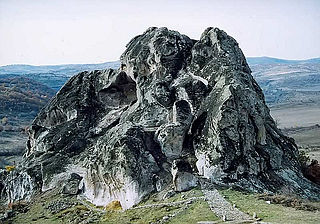
The Shang dynasty, also known as the Yin dynasty, was a Chinese royal dynasty founded by Tang of Shang that ruled in the Yellow River valley in the second millennium BC, traditionally succeeding the Xia dynasty and followed by the Western Zhou dynasty. The classic account of the Shang comes from texts such as the Book of Documents, Bamboo Annals and Records of the Grand Historian. Modern scholarship dates the dynasty between the 16th to 11th centuries BC, with more agreement surrounding the end date than beginning date.

The vast majority of surviving Tibetan art created before the mid-20th century is religious, with the main forms being thangka, paintings on cloth, mostly in a technique described as gouache or distemper, Tibetan Buddhist wall paintings, and small statues in bronze, or large ones in clay, stucco or wood. They were commissioned by religious establishments or by pious individuals for use within the practice of Tibetan Buddhism and were manufactured in large workshops by monks and lay artists, who are mostly unknown. Various types of religious objects, such as the phurba or ritual dagger, are finely made and lavishly decorated. Secular objects, in particular jewellery and textiles, were also made, with Chinese influences strong in the latter.

Liuhebafa quan is an internal Chinese martial art. It has been called "xinyi liuhebafa" (心意六合八法拳) and is also referred to as "water boxing" due to its principles.

Menshen or door gods are divine guardians of doors and gates in Chinese folk religions, used to protect against evil influences or to encourage the entrance of positive ones. They began as the divine pair Shenshu and Yulü under the Han, but the deified generals Qin Shubao and Yuchi Gong have been more popular since the Tang. In cases where a door god is affixed to a single door, Wei Zheng or Zhong Kui is commonly used.

Tommy Tam Fu-wing, known professionally by his stage name Ti Lung, is a Hong Kong actor, known for his numerous starring roles in a string of Shaw Brothers Studio's films, particularly The Duel, The Blood Brothers, Clans of Intrigue, The Avenging Eagle, The Sentimental Swordsman and its sequel, as well as the classic John Woo film A Better Tomorrow and its sequel.

Quillwork is a form of textile embellishment traditionally practiced by Indigenous peoples of North America that employs the quills of porcupines as an aesthetic element. Quills from bird feathers were also occasionally used in quillwork.

Cordyline fruticosa is an evergreen flowering plant in the family Asparagaceae. The plant is of great cultural importance to the traditional animistic religions of Austronesian and Papuan peoples of the Pacific Islands, New Zealand, Island Southeast Asia, and Papua New Guinea. It is also cultivated for food, traditional medicine, and as an ornamental for its variously colored leaves. It is identified by a wide variety of common names, including ti plant, palm lily, cabbage palm.

Lintel 24 is the designation given by modern archaeologists to an ancient Maya limestone sculpture from Yaxchilan, in modern Chiapas, Mexico. The lintel dates to about 723–726 AD, placing it within the Maya Late Classic period. Its mid-relief carving depicts the ruler of Yaxchilan, Itzamnaaj Bahlam III, and his consort Lady K’abal Xoc, performing a ceremony of bloodletting; the imagery is also accompanied by descriptive captions, and a signature by the sculptor, Mo’ Chaak.

Ghostwalk is a book that introduced a campaign setting for the 3rd edition of the Dungeons & Dragons game, similar to Forgotten Realms or Dragonlance. Unlike most other D&D settings, Ghostwalk was designed to be released as a single book containing all the material for the world.

The Empire of China was a short-lived attempt by statesman, general and president Yuan Shikai from late 1915 to early 1916 to reinstate monarchy in China, with himself as the Hongxian Emperor. The attempt was unsuccessful; it set back the Chinese republican cause by many years and fractured China into a period of conflict between various local warlords.

Yodŏk County is a county in South Hamgyŏng province, North Korea. Originally part of Yŏnghŭng county, it became a separate entity as part of the 1952 reorganization of local government.

Ah Muzen Cab is the Mayan god of bees and honey. He is possibly the same figure as "the Descending God" or "the Diving God" and is consistently depicted upside-down. The Temple of the Descending God is located in Tulum. The bees used by the Maya are Melipona beecheii and Melipona yucatanica, species of stingless bee.

The Jiahu gǔdí are the oldest known musical instruments from China, dating back to around 6000 BCE. Gudi means "bone flute" in Chinese.

Paleolithic religions are a set of spiritual beliefs and practices that are theorized to have appeared during the Paleolithic time period. Paleoanthropologists Andre Leroi-Gourhan and Annette Michelson believe unmistakably religious behavior emerged by the Upper Paleolithic, before 30,000 years ago at the latest, but behavioral patterns such as burial rites that one might characterize as religious — or as ancestral to religious behavior — reach back into the Middle Paleolithic, as early as 300,000 years ago, coinciding with the first appearance of Homo neanderthalensis and possibly Homo naledi.

Dwellers of the Forbidden City is an adventure module, or pre-packaged adventure booklet, ready for use by Dungeon Masters in the Dungeons & Dragons (D&D) fantasy role-playing game. The adventure was first used as a module for tournament play at the 1980 Origins Game Fair, and was later published by TSR in 1981 for use with the first edition Advanced Dungeons & Dragons rules. The module was written by game designer David "Zeb" Cook, who partly ascribes his hiring by TSR to his work on this module. In the adventure, the characters are hired to find an object taken to a lost oriental-style city, which has been taken over by a cult of snake-worshipers, the yuan-ti, and their servants, the mongrelmen and tasloi.

Steve Prescott is an artist whose work has appeared in role-playing games.

A gu is a type of ancient Chinese ritual bronze vessel from the Shang and Zhou dynasties. It was used to drink wine or to offer ritual libations.
David Griffith is an artist whose work has appeared in role-playing games.

Cocev Kamen is a hilltop cave site of volcanic origin near the town of Kratovo in the north-east of North Macedonia. Objects discovered near the cave suggest human presence since the Paleolithic. Authors agree that the site served as a gathering point for sacrificial rituals from the Neolithic, during the Bronze Age, throughout antiquity until the Middle Ages as clarified by an abundance of pottery shards, stone (flint) tools and bone fragments unearthed from the surrounding areas. Several caves and rock shelters are decorated with red figurative art work. Comparison with similar sites in Bulgaria and Italy suggests that the paintings are indeed prehistoric.

Ji (筓) and chai (钗) are generic term for hairpin in China. 'Ji' is also the term used for hairpins of the Qin dynasty. The earliest form of Chinese hair stick was found in the Neolithic Hemudu culture relics; the hair stick was called ji (笄), and were made from bones, horns, stones, and jade.



















